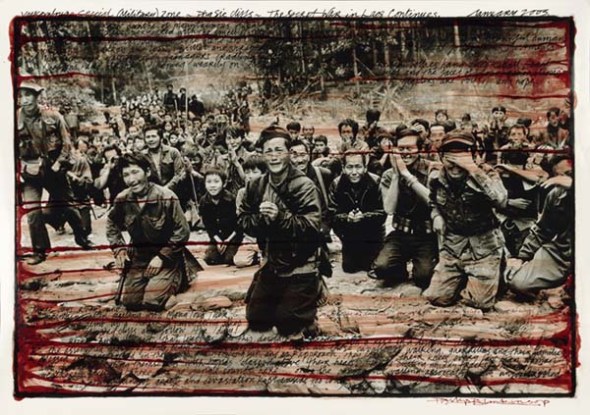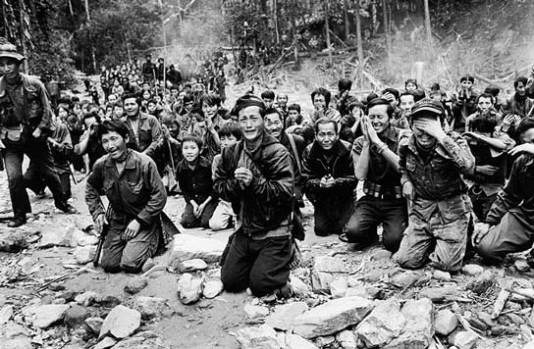Philip Blenkinsop’s Jungle Diary
In September 2012 Noor photographer Philip Blenkinsop became an Honorary Fellowship of Falmouth University and an exhibition of his work came to The Poly in Falmouth town. After the private view two hundred tickets were on sale to hear the photographer in conversation with Harry Hardie. Sold out completely, hearing Blenkinsop talk was a popular event and hoards of students from the university attended as well as a number of members of the public.
We were lucky enough to get a ticket early and headed over to the Poly for the private view. I won’t dwell on the masses of olives, cheesy twirls and garlic bruschetta that filled the rooms- I have already written a post below about my destain towards the environment created in a gallery. Neither will I focus on single images too much- the really interesting part of the evening was hearing Blenkinsop speak.
Full of energy, red wine and passion it was as good as any interview I saw at Perpignan last Summer. Harry Hardie asked the questions lingering in my mind and Blenkinsop responded with not so concise, but informative non the less, responses whilst two hundred eager listeners sat in silent admiration.
In my extensive notes I scribbled down quotes and comments made by the photographer and noticed a pattern emerging, I agreed with or could relate to the vast majority of these considered points of view and found myself furiously nodding along with his words in the darkness of the auditorium. Comments such as ‘I was inspired by what I saw in books but not by what I saw in newspapers’ rang true with me and from the beginning I knew that Blenkinsop was worth listening to for my own professional benefit photographically if nothing else.
Blenkinsop asked how many of the audience were aspiring photographers and a sea of hands rose, including mine, and my competitors and I listened avidly to his advice. Carry a light meter around always and know the work of Robert Frank and Cartier Bresson inside out was among his pearls of wisdom. The day after the interview I found myself sat on the number 41 to work scrutinizing every word of Cartier Bresson’s ‘The Minds Eye’ and coming home to dig out the light-meter I used in first year and had since forgotten somewhat about.
What struck me most about this well established practitioner, however, was his honesty. Despite stating that he photographs in order to give his subjects a voice, he accepts that this reason is hugely overused, cliched and that the true reality is that we may be able to provide a voice but the crucial aspect of prompting any sort of change is getting that voice heard. A topic he reverted back to throughout the interview he began by stating ‘I knew the power of the pictures whilst I was shooting, but no one gave a damn… I was wrong’ and later ‘I wish I knew how to make people care‘ closely followed by ‘You hope that people are going to empathize, some people do, but often not the right people’. Though read alone and removed from the context of the interview these quotes may appear defeatist they were in fact anything but. Despite appreciating that all too often images do not pull the heart strings of those in the position and with the power to make change Blenkinsop is in no way ready to simply accept this. During the interview his devotion, determination and endurance was evidence enough that despite understanding the harsh reality of how your images do, or indeed do not, affect certain people he would not give up trying.

Born of the frustration in trying to make his audience understand the pain, apprehension and dread he felt whilst photographing the images are abstractly painted with the photographer’s or a pig’s blood and are also scrawled on by the photographer, words which usually refer to his emotions and feelings. This technique is part of an avenue Blenkinsop is currently exploring as he doesn’t just want to put pictures on ‘a white wall’ where he believes that they become completely out of context. This idea of photographs being exhibited against clinical and often suffocating white walls is something I have struggled with for some time too, so once again I agree with Blenkinsop’s point of view.

Despite being an obvious admirer of Blenkinsop I must be critical and honest about my initial thoughts regarding this unusual approach. To me, it contradicted a quote of his from the interview : ‘Its not about you, you’re just a witness and a messenger. You have a serious responsibility. You owe them everything’. After hearing this I began wondering why, if it is not about the photographer, is it his blood we see on the images and why are those his feelings scrawled upon the print? The unique prints are just that, unique, and therefore raise questions within the audience. Whose blood is that? Is it real blood? What significance does that blood hold? The curiosity of the viewer may begin to detract somewhat from the image itself and as opposed to the attention being drawn to the subjects experiences it highlights the photographer’s.
Having reviewed the work some weeks after attending the interview and comparing the unique image and the original print, I can appreciate that the first is much more shocking, however, an average audience may not return to the images or indeed have the desire to find the two to compare side by side. Despite these concerns I respected Blenkinsop’s desires and ambitions to doing something different. It is refreshing to see somebody contemporary thinking this way and also reassuring in some ways. I am still unsure whether the unique pieces send the correct message or are the answer to shocking an audience into action but the most important thing to take away from this work is that we must never stop experimenting with unusual techniques, as Blenkinsop said himself ‘We need to up the game’ , just as he has done with ‘Jungle Diary’ .